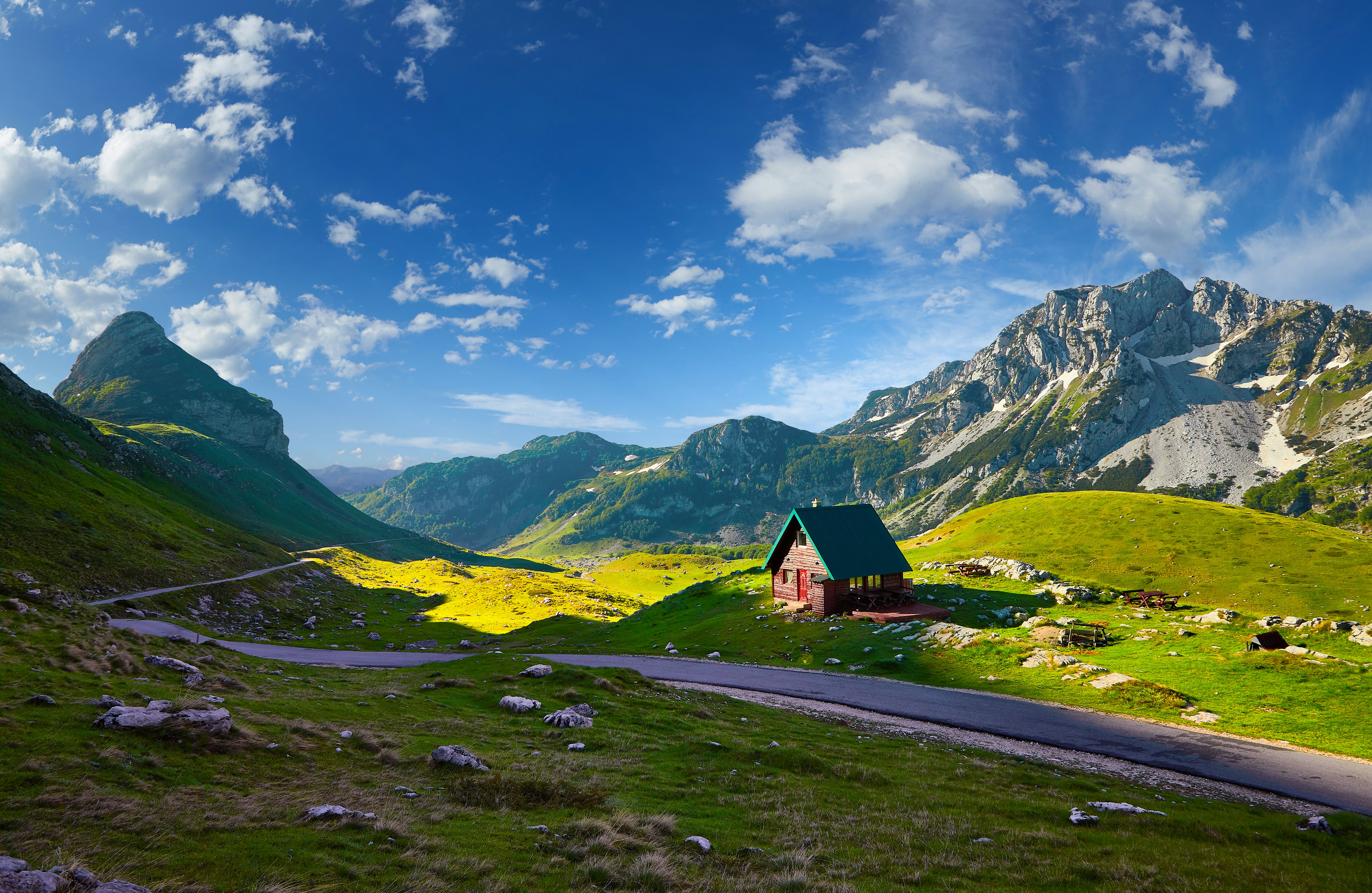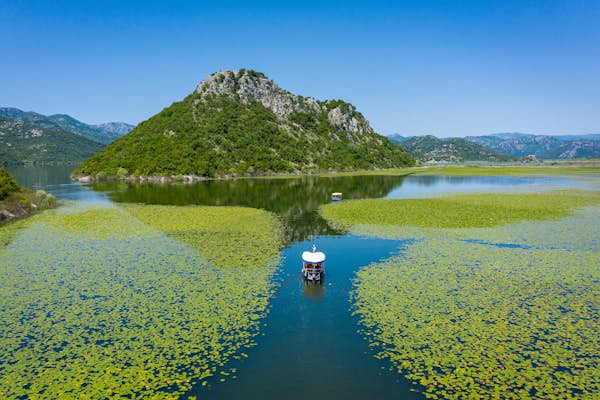Montenegro packs so much into a small area, it still surprises me it’s not on more people’s radars. Its gorgeous Adriatic coastline has secluded, rocky coves and great swathes of sandy beaches, beautifully preserved medieval towns and one of the most dramatic natural inlets anywhere on the Mediterranean. Inland, you’ll find rugged, spectacular mountains, which at times seem like they’ve been piled one on top of the other, sheer-sided canyons, pristine forests, and vast watery wetlands rich in birdlife – all of which make Montenegro a dream destination for an adventure holiday, be that hiking, cycling, kayaking or wild swimming.
There’s plenty of delicious Balkan cuisine to enjoy, and some lip-smackingly good wine too. It’s also good value compared to Italy and Croatia.
So whether you’re after culture, adventure, sand and sun, epic hiking, unforgettable views or simply a corner of Europe that can still feel a little bit off the map, you’ve come to the right place. Here’s everything you should know to help you plan your trip.
Advertisement

When should I go to Montenegro?
Montenegro is a year-round destination, from sun-soaked summers on the Adriatic coast to pleasant, balmy weather in spring and autumn (with average temperatures hovering around 18°C/64°F) and skiing in winter. On balance, the best times to visit are late spring or early summer, and autumn, when you’ll find a nice mix between sunny days, lower accommodation prices and fewer crowds. July and August are the hottest (30°C/86°F) and busiest months, particularly on the coast, while November tends to see some of the heaviest rainfall.
If you’re hiking, the picture is slightly different. The hiking season in the mountains of Montenegro runs from mid-June to early October. Come any earlier and you can expect snow on passes, come later and you might find yourself caught in the first snowfall of the coming winter.
How much time should I spend in Montenegro?
Allow a week to see highlights along the coast, or (infinitely preferable) two weeks to see the coast plus some of the spectacular landscapes and national parks further inland. Throw in a multiday hike and you could easily spend more time here. Yes, Montenegro is a small country and you can get from one side to the other fairly quickly, but this is a country tailor-made for slow travel, so you’ll have a much more authentic and rewarding experience if you slow down to match.

Is it easy to get in and around Montenegro?
The main airport lies 11km (7 miles) from Podgorica’s city center. Buses run between Podgorica’s main bus station and the airport – although the bus service has been known to disappear in the past. You can book a taxi through Welcome Pickups, which will cost €15–20 (US$17–$23), otherwise you’ll also find taxis waiting outside the airport, which are likely to charge around €25 (US$28).
Alternatively, more intrepid and budget-conscious travelers can take the local train. This is perfectly straightforward, takes just seven minutes (plus a short walk) and costs €1.20 (US$1.35). From the main railway station in Podgorica (behind the bus station), take a train towards Bari and get off at Aerodrom. The station is just over 1km (0.6 miles) from the airport terminal building, it looks more like a shed than a station, and the trains have seen better days, but they will get you between the city and the airport nonetheless. Cross the railway tracks and follow the road east – it’s a 15-minute walk from the station to the airport.
Montenegro has another airport at Tivat on the coast, and ferries run between the port of Bar and Italy. Land borders with Croatia, Bosnia, Serbia and Albania mean you can easily reach Montenegro from these countries by car or by bike. Getting around Montenegro by public transportation is easy enough – the bus station in Podgorica has services to Kotor, Budva, Žabljak and Plav for example, and there are plenty of minibuses running along the coast.
Advertisement

Top things to do in Montenegro
Visit the city of Kotor, a UNESCO World Heritage Site
No city in Montenegro makes more of an impression than Kotor, a beautifully preserved walled medieval city, which has atmosphere in spades. It gives the better-known Croatian city of Dubrovnik to the northwest a decent run for its money.
Clinging to the shore of the Bay of Kotor beneath soaring crags bristling with fortifications, Kotor’s UNESCO-listed old town center is a jumble of narrow streets and alleys, enclosed by walls, and punctuated by spacious piazzas and handsome Venetian-style palaces, bijou churches and a large imposing cathedral. It’s a place to wander the meandering streets, stop for a coffee at a small cafe or bar, and linger for as long as possible. Follow the steps at the back of the old town (take water and a sunhat!), which lead up alongside the fortifications to the staggeringly photogenic little Church of Our Lady of Remedy (Crkva Gospe od Zdravlja), with the terracotta tiled roofs of the old town clustered below (and doubtless a large cruise ship docking not far away).

Hike through Durmitor National Park
Montenegro’s best-known national park, Durmitor, is a stupendously impressive jumble of rocky mountains, lakes and crags, with enough trails to keep most keen hikers busy for days, if not weeks. It’s also home to the spectacularly deep Tara Canyon, one of the best places in Montenegro for white water rafting.
The gateway to Durmitor is the little town of Žabljak, which makes a good base for day walks in the hills, or the main starting point for longer treks. For a very short walk, it’s hard to beat Crno jezero (Black Lake), a ridiculously photogenic spot just outside Žabljak, with the nearby mountain peaks reflected in its surface. Or head for Curevac (you can easily reach the nearby parking spot by e-bike from Žabljak) from where there are dramatic views down into the depths of the Tara Canyon.
For longer trips head for Bobotov Kuk, one of the country’s highest mountains – some scrambling skills and a decent head for heights are required here – or to Škrčko jezero. Remember to take adequate water (this is limestone country, so you’ll find very few springs), and suitable clothing. The weather in the mountains of Montenegro is famously fickle and capable of changing dramatically.
Witness and birdlife and impressive landscapes Lake Skadar
The largest lake in the Balkans, straddling the border between Montenegro and Albania, Lake Skadar (Skadarsko jezero) is a vast, watery wilderness surrounded by mountains and reed-beds, with spectacular birdlife including Dalmatian pelicans, an amazingly beautiful and unique landscape in Montenegro and also one of the most important wetland areas in southeast Europe. Head to the tiny town of Virpazar and join a local boat trip on the lake, dine on local freshwater fish, and enjoy wine from the nearby Crmnica wine region, which produces some of Montenegro’s best wines.

Visit a cliff-side monastery
Ostrog, Montenegro’s best-known monastery – a sight you’re unlikely to forget in a hurry – is set within a cliff face high above the valley floor. It’s a 3km (2-mile) walk up to the cave-church from the lower monastery, a route that pilgrims follow barefoot, although that’s certainly not compulsory for other visitors. Taxis cover the route from Nikšič to the Lower Monastery, or you can drive from Danilovgrad. Ostrog is still a working monastery, so dress conservatively when visiting the site.
Explore the Bay of Kotor
The most beautiful part of Montenegro’s Adriatic coastline, the Bay of Kotor (Boka Kotorska) is a deeply indented, fjord-like inlet, surrounded by a wall of mountains – though it’s worth saying, it’s not actually a fjord, despite what many descriptions would have you believe.
Its twin, anvil-shaped wings are entered through a narrow channel, which is itself separated from the open sea by another body of water, the Tivatski zaliv. For the best views, head to Perast, a small seaside village overlooking the little islands of Our Lady of the Rocks (Gospa od Škrpjela) and St George (Sveti Đorđe) – the former an artificial island with a church, the latter a natural rocky islet with a monastery. Boats take passengers over to the islands from Perast. The other stellar view – in truth, there are many more – is from Vrmac, the ridge dividing the Bay of Kotor from the Tivatski zaliv.

Visit the ruins of Stari Bar
Stari Bar (Old Bar) is a beautifully atmospheric set of ruins, some 4km (2.5 miles) inland from the modern port of Bar, set in the olive-clad foothills of Mt Rumija. The main reason for coming here, aside from the view of the walled old town, is the stretch of little restaurants and cafes in the rambling cobbled street alongside it. Duck into one of these and tuck into delicious Montenegrin and Albanian cuisine, or just sip a Turkish coffee and watch the world go by.
My favorite thing to do in Montenegro
It’s the mountains that always draw me back to Montenegro. From the first time I saw a photo of the view from Bobotov kuk, looking down across the vivid blue of Škrčko jezero surrounded by steep-sided mountains and vertiginous scree slopes – it was an old postcard, pinned to the wall of a Croatian hiking club – I was hooked. Few places can claim so much jaw-dropping mountain scenery, and such a wealth of fantastic hiking routes, within such a small area.
Some all-time favorites would be the trans-border Peaks of the Balkans trail in the Prokletije mountains, the rugged peaks of central Durmitor, the Komovi peaks on the Albanian border, and Rumija, which might not be very high but has genuinely epic views across Lake Skadar on one side and the Adriatic coast on the other.

How much money do I need for Montenegro?
Montenegro can be very good value, with prices that are generally much lower than neighboring Croatia – although having said that, prices on the coast especially in Kotor and Budva have crept up much more in recent years, and there are some places (Sfeti Stefan comes to mind) where the prices can only be described as eye-watering and a little absurd. Cards are widely accepted but expect to pay in cash at cafes, market stalls and on local buses.
-
Double room in a hotel in Podgorica: from €80 (US$90)
-
Bed in hostel dorm in Kotor: €27 (US$30)
-
Main course (freshwater fish) at a restaurant: €12 (US$13.50)
-
Mixed grill for two at a restaurant: €26 (US$29)Pizza in Kotor: €8.40 (US$9.50)
-
Šopska salata (salad side dish): €2 (US$2.25)
-
Local beer (0.5l): €2.50 (US$2.80)
-
Coffee (espresso): €1 (US$1.10)
-
Bus ticket from Podgorica to Kotor: €8 (US$9)
-
Bus ticket frin Kotor to Tivat: €2.50 (US$2.80)
-
Taxi from Podgorica Airport to Podgorica bus station: €15–€25 (US$17–$28)

